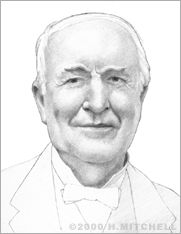Thomas Edison
Without a doubt, the greatest inventor of the modern era has been Thomas Edison. Many of his over one thousand inventions have profoundly changed the lives of nearly everyone in the world.
Thomas Alva Edison was born in Milan, Ohio on February 11, 1847. In 1854, his family moved to Port Huron, Michigan. There, "Al's" favorite hobbies were reading and performing chemistry experiments in his basement lab. However, his teachers considered young Edison a failure, and his mother soon decided to homeschool him.
Edison's first job in 1859 was operating a newstand on the railroad that ran from Port Huron to Detroit. To make the trips more interesting, Edison installed a printing press and chemistry lab in a boxcar. In 1862, he learned how to use a railroad telegraph. Edison then spent many years traveling around Canada and the U.S., working as a telegraph operator and doing scientific experiments in his free time. Finally, in 1869, he decided to become a full-time inventor.
On June 1 of that year, Edison was granted his first patent (#90,646) for an electric voting machine. But no one wanted to use the machine, and Edison resolved never again to invent what would not sell. His next invention fared much better: an improved stock market tickertape machine (1869), which earned him an instant $40,000 (about $700,000 today). With his friend Franklin L. Pope, Edison formed an electrical engineering firm based in Newark, New Jersey. With Pope, and later alone, Edison eventually earned about 200 patents for telegraph systems and devices.
In 1876, in Menlo Park, New Jersey, Edison founded his famous "invention factory." Edison, "the Wizard of Menlo Park," was a workaholic and a demanding employer, but he did not resent failures in the lab. Instead, his view on failure was "that's one more way it won't work, so we're closer to a solution." Edison's first great Menlo Park invention was the phonograph (1877), though he did not bring it to market for ten years. During this time, he was busy with his greatest project: a workable electric light system that would replace candles and gaslight forever, at home and in public.
In 1878, Edison created his prototype incandescent light bulb – a thin strip of paper attached to wires, enclosed in a vacuum inside a glass bulb. When electricity flowed into the paper "filament," it heated up and glowed. The only problem was that the paper burnt out very quickly. After thousands of tests, an "Edison Pioneer" named Lewis H. Latimer found the optimal filament material – carbonized cotton thread – in 1897.
Edison installed the first reliable, durable electric lights in his own labs and later built the first public power station in Manhattan's financial district in 1882. However, Edison's DC-current system had only a three-mile range and was later superseded by Westinghouse and Tesla's AC-current system.
By that time, Edison had built a new and much bigger research complex (now a national monument) in West Orange, New Jersey. His first project there was to redesign his phonograph, in light of recent improvements made by others. In 1888, Edison marketed a wax-cylinder phonograph as a dictation machine, and later, in 1896, as a musical home entertainment system. These commercial efforts were, by and large, failures, but Edison continued to refine his favorite invention into the 1920s.
In 1889, William Dickson, an associate working under Edison's direction, invented the celluloid-strip motion picture camera and projector. Silent movies were viewed inside the machine through a peephole. Although Edison later broke with Dickson, George Eastman and others helped Edison establish the basis of the motion picture industry.
After 1911, Edison was mainly dissatisfied in his work, feeling that many of his ideas were being ignored or worse yet, stolen. Throughout the 1920s, he also suffered from poor health. He died on October 18, 1931 at the age of 84.
In total, Edison accumulated 1,093 U.S. patents. Only a few inventors have earned even half as many. Edison's inventions that are not mentioned above include the printing telegraph, the electric "stencil pen," a magnetic mining process, an electrical torpedo, a synthetic rubber, and improved alkaline batteries, cement mixers, and microphones.
It must be said that Edison used other inventors' ideas much more freely than he shared his own. For example, the wax cylinder phonograph was first patented by Chichester A. Bell and Charles Sumner Tainter (1886), whose offer of a joint venture Edison rejected. The disc "gramophone" was first patented by Emile Berliner in 1887. Even the so-called "Edison Effect," the observed emission of electrons from a hot filament, was actually discovered by an Edison engineer named William J. Hammer in 1883.
Regardless, nothing can gainsay the tremendous effect that Edison's career as a whole has had on our everyday lives. By the volume, variety, and spectacularity of his inventions, Edison – more than any other person – made it seem as though no miracle was beyond the reach of modern American technology. As an inspiration to aspiring engineers and inventors, then and now, Edison is peerless. Indeed, above all others, as his Congressional Medal of Honor certificate declared: "He illuminated the path of progress by his inventions."


